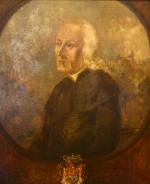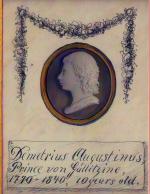![header=[Marker Text] body=[Here is the tomb of the Russian prince-priest who gave up a life of ease for a frontier mission. Founder of Loretto, Catholic colony, 1799. St. Michael's is on the site of his chapel. He died here May 6, 1840] sign](http://explorepahistory.com/kora/files/1/10/1-A-298-139-ExplorePAHistory-a0h9j4-a_450.jpg)
Mouse over for marker text
Name:
Demetrius Gallitzin, Catholic colony of Loretto
Region:
Laurel Highlands/Southern Alleghenies
County:
Cambria
Marker Location:
SR 1005 at Loretto
Dedication Date:
August 19, 1947
Behind the Marker
Father Demetrius Gallitzin
In the late 1700s, the woods of western Pennsylvania drew men and women eager to create new lives and communities. In 1788, Captain Michael McGuire, a Maryland Catholic, purchased 12,000 acres from the Commonwealth near the headwaters of the Clearfield Creek, high in the Allegheny mountains in what would later become Cambria County, Pennsylvania. There he and his family carved out a small settlement, some twenty miles from the closest neighbors, where Catholics could live unmolested by the largely Scots-Irish Presbyterian, Lutheran and Reformed German population in the area. When McGuire died in 1793 he left 400 acres in trust to John Carroll, the United States' first Catholic bishop, to attract Catholic clergy.
In 1796, Father Augustine Smith received a call to perform last rites for a Protestant woman, who lived in a place called McGuire's Settlement, some 150 miles west of his station at Conewago, Pennsylvania. Father Smith made the trip, and became so entranced by the small, isolated village of Maryland Catholics that he decided to stay. Here, in the following decades Smith would build the first Catholic Church in Pennsylvania, west of the Alleghenies, then minister to a thriving Catholic community that he funded out of his own pocket.
The humble Father Augustine Smith was, in fact, Prince Demetrius Gallitzin. Born on December 22, 1770 into one of the oldest, wealthiest, and most illustrious families of Russia, Gallitzen was the son of Prince Demetrius, Sr., the Russian ambassador to Holland, and an intimate acquaintance of Diderot, Voltaire, d'Alembert, and other great progressive thinkers of the day. Although nominally Russian Orthodox, Gallitzin was deeply influenced by his Catholic mother, the Countess Amalie, only daughter of the then celebrated Prussian Field-Marshal von Schmettau.
In 1787, the younger Demetrius Gallitzin converted to Catholicism. Educated by the best scholars of the age, he received a high commission in the Russian Army, and at the age of twenty-one, as was customary for Russian aristocrats, prepared for his trip abroad. But since travel was next to impossible in Europe after the French Revolution, it was decided the Prince should visit America. In August of 1792, he arrived at Baltimore, where he met Bishop John Carroll, the first and at the time the only Catholic bishop in the United States, and decided to enter the priesthood. In March 1795, Augustine Smith - the name that Gallitzin had assumed when he left Russia - was ordained, the first priest in history to receive all his orders in the United States of America.
After the Church granted him permission to move to McGuire's Settlement, Gallitzin in 1799 purchased land next to McGuire's 400 acres, and erected a log church. There, he established a Catholic colony that he named "Loretto," after the city of Loreto in Italy. In the decades that followed, Gallitzin transformed Loretto into the cradle of Catholicism in western Pennsylvania. Using his own money and loans from eastern banks and businessmen contracted against his future inheritance, he purchased large portions of land adjoining the settlement, which he sold in small tracts to the incoming colonists at a very low price and on easy terms. He financed the construction of saw-mills, grist-mills, and tanneries, and established other industries for the material benefit of his flock. In so doing, he attracted three to four thousand residents to the Catholic colony.
For all his efforts, Gallitzin embodied several characteristics of the American Catholic church which distinguished it from its Protestant counterparts. Unlike Bishop Carroll and Maryland Catholics, who hoped to construct a more "American" church that allowed for autonomy from Europe and more local and lay control, Gallitzin embodied the authoritarian and anti-republican characteristics the church increasingly took on after the French Revolution. Since he put up the money for his parish, he was able to silence opponents who sought a more "republican" church.
In the early 1800s most Catholics in the United States were immigrants, and most of those, poor Irish. A Russian immigrant presiding over "Papists," Gallitzin and his flock soon attracted the suspicion and hostility of their neighbors, who, like many American Protestants feared that all Catholics were part of a Popish plot to overthrow the Republic. In 1814, Gallitzin wrote a "Defense of Catholic Principles." In this and later writings he did his best to combat American fears and to win converts.
The Catholic Church grew rapidly in Pennsylvania during Gallitzin's residence in Loretto. There were only five priests and about 10,000 Catholics in the state in 1790; by 1800 the number had more than doubled. Philadelphia, once part of the Baltimore diocese, became a separate diocese in 1808; Pittsburgh in 1842, and Erie in 1853.
Gallitzin expected to pay off the $150,000 debt he incurred building Loretto through his inheritance. But when the Russian government disinherited him for becoming a Catholic and a priest, and the German prince who had married his sister squandered both his and her inheritance, he was compelled, in 1827, to appeal to the charitable public. Demetrius Gallitzin died on May 6, 1840 and is buried at St. Michael's Cemetery in Loretto. Loretto's large stone church, financed by steel baron Charles Schwab, was consecrated in 1901. Next to it, one can see a bronze statue of the princely priest who had founded and nurtured the community through the first forty years of its existence.
Charles Schwab, was consecrated in 1901. Next to it, one can see a bronze statue of the princely priest who had founded and nurtured the community through the first forty years of its existence.
"Whatever differences on points of doctrine may exist amongst the different denominations of Christians, all should be united in the bonds of charity, all should pray for one another, all should be willing to assist one another; and, where we are compelled to disapprove of our neighbor's doctrine, let our disapprobation fall upon his doctrine only, not upon his person."
Father Demetrius Gallitzin
In the late 1700s, the woods of western Pennsylvania drew men and women eager to create new lives and communities. In 1788, Captain Michael McGuire, a Maryland Catholic, purchased 12,000 acres from the Commonwealth near the headwaters of the Clearfield Creek, high in the Allegheny mountains in what would later become Cambria County, Pennsylvania. There he and his family carved out a small settlement, some twenty miles from the closest neighbors, where Catholics could live unmolested by the largely Scots-Irish Presbyterian, Lutheran and Reformed German population in the area. When McGuire died in 1793 he left 400 acres in trust to John Carroll, the United States' first Catholic bishop, to attract Catholic clergy.
In 1796, Father Augustine Smith received a call to perform last rites for a Protestant woman, who lived in a place called McGuire's Settlement, some 150 miles west of his station at Conewago, Pennsylvania. Father Smith made the trip, and became so entranced by the small, isolated village of Maryland Catholics that he decided to stay. Here, in the following decades Smith would build the first Catholic Church in Pennsylvania, west of the Alleghenies, then minister to a thriving Catholic community that he funded out of his own pocket.
The humble Father Augustine Smith was, in fact, Prince Demetrius Gallitzin. Born on December 22, 1770 into one of the oldest, wealthiest, and most illustrious families of Russia, Gallitzen was the son of Prince Demetrius, Sr., the Russian ambassador to Holland, and an intimate acquaintance of Diderot, Voltaire, d'Alembert, and other great progressive thinkers of the day. Although nominally Russian Orthodox, Gallitzin was deeply influenced by his Catholic mother, the Countess Amalie, only daughter of the then celebrated Prussian Field-Marshal von Schmettau.
In 1787, the younger Demetrius Gallitzin converted to Catholicism. Educated by the best scholars of the age, he received a high commission in the Russian Army, and at the age of twenty-one, as was customary for Russian aristocrats, prepared for his trip abroad. But since travel was next to impossible in Europe after the French Revolution, it was decided the Prince should visit America. In August of 1792, he arrived at Baltimore, where he met Bishop John Carroll, the first and at the time the only Catholic bishop in the United States, and decided to enter the priesthood. In March 1795, Augustine Smith - the name that Gallitzin had assumed when he left Russia - was ordained, the first priest in history to receive all his orders in the United States of America.
After the Church granted him permission to move to McGuire's Settlement, Gallitzin in 1799 purchased land next to McGuire's 400 acres, and erected a log church. There, he established a Catholic colony that he named "Loretto," after the city of Loreto in Italy. In the decades that followed, Gallitzin transformed Loretto into the cradle of Catholicism in western Pennsylvania. Using his own money and loans from eastern banks and businessmen contracted against his future inheritance, he purchased large portions of land adjoining the settlement, which he sold in small tracts to the incoming colonists at a very low price and on easy terms. He financed the construction of saw-mills, grist-mills, and tanneries, and established other industries for the material benefit of his flock. In so doing, he attracted three to four thousand residents to the Catholic colony.
For all his efforts, Gallitzin embodied several characteristics of the American Catholic church which distinguished it from its Protestant counterparts. Unlike Bishop Carroll and Maryland Catholics, who hoped to construct a more "American" church that allowed for autonomy from Europe and more local and lay control, Gallitzin embodied the authoritarian and anti-republican characteristics the church increasingly took on after the French Revolution. Since he put up the money for his parish, he was able to silence opponents who sought a more "republican" church.
In the early 1800s most Catholics in the United States were immigrants, and most of those, poor Irish. A Russian immigrant presiding over "Papists," Gallitzin and his flock soon attracted the suspicion and hostility of their neighbors, who, like many American Protestants feared that all Catholics were part of a Popish plot to overthrow the Republic. In 1814, Gallitzin wrote a "Defense of Catholic Principles." In this and later writings he did his best to combat American fears and to win converts.
The Catholic Church grew rapidly in Pennsylvania during Gallitzin's residence in Loretto. There were only five priests and about 10,000 Catholics in the state in 1790; by 1800 the number had more than doubled. Philadelphia, once part of the Baltimore diocese, became a separate diocese in 1808; Pittsburgh in 1842, and Erie in 1853.
Gallitzin expected to pay off the $150,000 debt he incurred building Loretto through his inheritance. But when the Russian government disinherited him for becoming a Catholic and a priest, and the German prince who had married his sister squandered both his and her inheritance, he was compelled, in 1827, to appeal to the charitable public. Demetrius Gallitzin died on May 6, 1840 and is buried at St. Michael's Cemetery in Loretto. Loretto's large stone church, financed by steel baron









